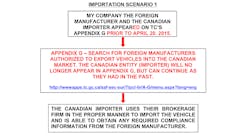Class 8 truck orders were the second highest ever in October (45,639 N.A.) and trailer orders (46,267 U.S.) set a record, shattering the old mark by thousands. Class 8 orders for November are 40,608 and 39,356 for trailers. While these numbers are huge, they are significantly inflated due to sales strategies recently employed by some of the OEMs.
Order Inflation
Trailer OEMs and at least one truck OEM have motivated the larger fleets to place orders for most of their anticipated equipment requirements through the second quarter of next year. In other words, they pulled purchase orders forward into October and November which would have normally been received in December 2014 through April 2015. So, although the order numbers are record setting, they are not truly reflective of the current equipment market.
What are the Real Order Numbers?
For Class 8 trucks there are two methods which can be used to determine what the “real” orders were in October and November. If historical OEM market share percentages are applied to the orders, approximately 22,000 orders were pulled ahead and entered into the current backlog. If a statistical order forecast is generated (using software), around 30,000 orders were booked early. Based on the market share method, “real orders” equaled 31,300 in October and 33,500 in November. These are still very strong numbers and much more reflective of the current Class 8 market.
Only the statistical method can be used for trailers because there are too many OEMs to be able to use the estimated market share method. The statistical forecast equals 31,000 units for October and 32,000 for November or a “pre-order” total of interestingly around 22,000 also. Just as with trucks, the numbers are robust, but not earth-shattering, and consistent with a “peak-cycle” and FTR forecasts.
Why Did the Fleets Place the Big Orders Now?
Class 8 production is running very near to full capacity. Fleets were no doubt asked to place orders to reserve slots in future production plans. Of course it would be unfortunate for a fleet to need trucks in April but have to wait several months to receive them. It is uncertain how many, if any, price incentives were offered to the fleets to order early.
It is estimated that current industry capacity is around 330,000 trucks. This is down 12% from the 2006 capacity of 375,000. Several plants were closed due to the impact of the Great Recession and the significant changes in OEM market share since that time. OEMs continue to add some capacity and it is possible that they can squeeze out enough units to be running at a yearly rate of 342,000 sometime mid-year.
It is a similar story on the trailer side. Many OEMs are running lines at full capacity, so fleets do have an incentive to reserve build slots. However, due to the more competitive nature of the trailer market, some OEMs were locking in 2015 orders at 2014 prices. Next year, prices are reportedly going to increase due to increased costs of steel, aluminum, wood, and rubber. Of course, with the recent weakness in the world economy and drop in commodity prices, this may be more salesmanship than reality.
Why did OEM’s Pull Purchase Orders Ahead?
For Class 8, locking up future orders would be a strategy to gain or maintain market share. However, with production slots scarce and market shares fairly stable, this doesn’t provide much benefit. It does help with production planning and provides a customer relations benefit because your best customers are assured of getting build slots. But this strategy also entails some risk. Orders are received at a price based on expected costs. If those costs rise, profits or customer relations take a hit. Also, if OEMs with build slots cancel them too late, they may not get refilled and precious capacity might get wasted.
There is one other scenario to consider here. An OEM might employ this strategy if it was planning to significantly increase production capacity sometime in 2015. You would want to make sure you had much of your current capacity filled before trying to grab additional orders.
On the trailer side, there is more incentive to employ this strategy. Market share is more fluid because there is less brand loyalty. Reportedly, one large OEM started seeking to pull ahead purchase orders and then most of the major players jumped in the game. Yes, the pricing risk still exists, but the potential market share gain increases the reward.
Hot or Not?
Even though the humongous orders and flat-out production give the impression of an over-heated Class 8 market, it really isn’t. Even after the tremendous October and November orders, there were still some build slots open in the short-term. November retail sales were down 2% versus October on a per day basis. This means fleets are not rushing to put new units into service. While this market appears smoking hot overall, it is currently functioning fairly normal for a growing market.
What Now?
If we assume that 25,000 Class 8 pre-orders are in the backlog, then orders could be 5,000 fewer than expected for the next five months. This assumes the OEMs do not begin pulling purchase orders ahead from the second half of the year. Just as we temper our enthusiasm over the recent order barrage, we should not worry much when orders begin to moderate. Trailer orders should also return to a more predictable pattern soon and the order “pull-ahead” should result in lower than normal orders in Q1.
It is also important to note that because these orders were placed so far in advance, they may be quickly cancelled if an “economic shock” hits in 2015. For example, trailer orders flew out of the backlog after the financial crisis in 2007. There is no penalty for cancelling these orders. So fleets had incentives to order ahead, but no risk in doing so.
The Great Recession devastated the heavy-duty equipment market. When the recovery began it was so weak that everyone was very cautious, and minimizing risk was the prominent strategy. This created significant pent-up demand and now that a real recovery is happening, the industry is playing catch-up.
Of course this was tough to forecast because pent-up demand is difficult to measure, and its release difficult to predict. The current situation is causing fleets to place orders much further out than normal, which skews the traditional numbers used to forecast future demand. This makes 2015 forecasts tenuous, so stay tuned.




